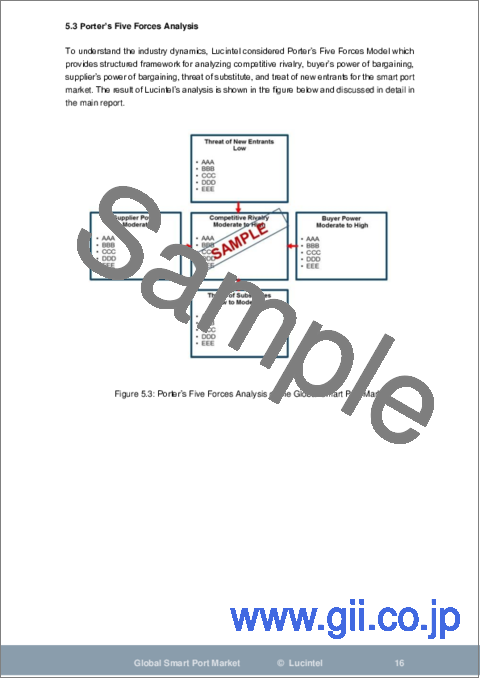|
|
市場調査レポート
商品コード
1496991
スマートポート市場:動向、機会、競合分析【2024-2030年】Smart Port Market: Trends, Opportunities and Competitive Analysis [2024-2030] |
||||||
カスタマイズ可能
適宜更新あり
|
|||||||
| スマートポート市場:動向、機会、競合分析【2024-2030年】 |
|
出版日: 2024年04月29日
発行: Lucintel
ページ情報: 英文 150 Pages
納期: 3営業日
|
全表示
- 概要
- 目次
スマートポート市場の動向と予測
世界のスマートポート市場は、2024年から2030年までのCAGRが22.4%で、2030年までに推定112億米ドルに達すると予測されます。この市場の主な促進要因は、スマートポートに対する政府のイニシアチブの増加、海上輸送の増加、IoT技術の採用の高まりです。スマートポート市場の将来は、海港と内陸港湾市場に機会があり、有望視されています。
スマートポート市場の洞察
- Lucintelの予測によると、港湾の生産能力を向上させるためにインダストリー4.0技術の採用が増加しているため、予測期間中、プロセス自動化が最大の技術セグメントであり続けると予想されます。
- この市場の中で、海港は強力なデジタル技術、スマートセンサー、IoTを装備しているため、より大きな港湾タイプセグメントであり続けるでしょう。
- アジア太平洋諸国は、人工知能やブロックチェーンのような新技術のための港湾への投資が増加しており、シンガポールや香港のような国々での貿易事業が堅調に発展しているため、予測期間中も最大のセグメントであり続けると思われます。
よくある質問
Q1.市場規模は:
A1.世界のスマートポート市場は、2028年までに推定112億米ドルに達する見込みです。
Q2.市場の成長予測は:
A2.世界のスマートポート市場は、2024年から2030年にかけてCAGR 22,4%で成長すると予想されます。
Q3.市場の成長に影響を与える主な促進要因は:
A3.この市場の主な促進要因は、スマートポートに対する政府のイニシアチブの増加、海上輸送の増加、IoT技術の採用率の上昇です。
Q4.市場の主要セグメントは:
A4.スマートポート市場の将来性は、海港と内陸港湾市場における機会により有望視されています。
Q5.スマートポートの主要企業は?
A5.スマートポートの主要企業の一部は以下の通りです:
- ABB
- IBM
- Kaleris
- Siemens
- General Electric
- Cisco
- Trelleborg
- ZPMC
- Liebherr
- Accenture
Q6.将来的に最も大きくなるスマートポートセグメントはどれですか?
A6.Lucintelの予測では、港湾の生産能力を向上させるためにインダストリー4.0技術の採用が増加しているため、予測期間中、プロセスオートメーションが最大の技術セグメントであり続けると予想されています。
Q7.市場において、今後5年間に最大になると予想される地域は:
A7.アジア太平洋は、人工知能やブロックチェーンのような新技術のための港湾への投資が増加していること、シンガポールや香港のような国々で貿易ビジネスが堅調に発展していることから、予測期間中も最大のセグメントであり続けるでしょう。
Q8.レポートのカスタマイズは可能か:
A8.はい、Lucintelは追加費用なしで10%のカスタマイズを提供します。
目次
第1章 エグゼクティブサマリー
第2章 世界のスマートポート市場:市場力学
- イントロダクション、背景、分類
- サプライチェーン
- 業界の促進要因と課題
第3章 2018年から2030年までの市場動向と予測分析
- マクロ経済動向(2018~2023年)と予測(2024~2030年)
- 世界のスマートポート市場の動向(2018~2023年)と予測(2024~2030年)
- 要素別世界スマートポート市場
- ターミナル自動化と貨物処理
- 港湾コミュニティシステム(PCS)
- スマートな安全とセキュリティ
- 交通管理システム(TMS)
- スマートポートインフラストラクチャ
- 技術別世界スマートポート市場
- プロセス自動化
- モノのインターネット(IoT)
- 人工知能(AI)
- ブロックチェーン
- 処理能力別世界スマートポート市場
- 非常に混雑した港
- 中程度の混雑の港
- 混雑のない港
- 港湾タイプ別世界スマートポート市場
- 港湾
- 内陸港
第4章 2018年から2030年までの地域別市場動向と予測分析
- 地域別世界スマートポート市場
- 北米のスマートポート市場
- 欧州のスマートポート市場
- アジア太平洋のスマートポート市場
- その他地域のスマートポート市場
第5章 競合分析
- 製品ポートフォリオ分析
- 業務統合
- ポーターのファイブフォース分析
第6章 成長機会と戦略分析
- 成長機会分析
- 要素別の世界スマートポート市場の成長機会
- 技術別の世界スマートポート市場の成長機会
- 処理能力容量別の世界スマートポート市場の成長機会
- ポートタイプ別の世界スマートポート市場の成長機会
- 地域別の世界スマートポート市場の成長機会
- 世界のスマートポート市場の新たな動向
- 戦略分析
- 新製品の開発
- 世界のスマートポート市場の容量拡大
- 世界のスマートポート市場における合併、買収、合弁事業
- 認証とライセンシング
第7章 主要企業の企業プロファイル
- ABB
- IBM
- Kaleris
- Siemens
- General Electric
- Cisco
- Trelleborg
- ZPMC
- Liebherr
- Accenture
Smart Port Market Trends and Forecast
The future of the smart port market looks promising with opportunities in the seaport and inland port markets. The global smart port market is expected to reach an estimated $11.2 billion by 2030 with a CAGR of 22.4% from 2024 to 2030. The major drivers for this market are increasing government initiatives for smart port, growing maritime transportation, and rising adoption of IoT technology.
A more than 150-page report is developed to help in your business decisions. A sample figure with some insights is shown below.
Smart Port Market by Segment
The study includes trends and forecast for the global smart port market by element, technology, throughput capacity, port type, and region, as follows:
Smart Port Market by Element [Shipment Analysis by Value from 2018 to 2030]:
- Terminal Automation and Cargo Handling
- Port Community Systems (PCS)
- Smart Safety and Security
- Traffic Management Systems (TMS)
- Smart Port Infrastructure
Smart Port Market by Technology [Shipment Analysis by Value from 2018 to 2030]:
- Process Automation
- Internet of Things (IoT)
- Artificial Intelligence (AI)
- Blockchain
Smart Port Market by Throughput Capacity [Shipment Analysis by Value from 2018 to 2030]:
- Extensively Busy Ports
- Moderately Busy Ports
- Scarcely Busy Ports
Smart Port Market by Port Type [Shipment Analysis by Value from 2018 to 2030]:
- Seaports
- Inland Ports
Smart Port Market by Region [Shipment Analysis by Value from 2018 to 2030]:
- North America
- Europe
- Asia Pacific
- The Rest of the World
List of Smart Port Companies
Companies in the market compete on the basis of product quality offered. Major players in this market focus on expanding their manufacturing facilities, R&D investments, infrastructural development, and leverage integration opportunities across the value chain. With these strategies, smart port companies cater to increasing demand, ensure competitive effectiveness, develop innovative products and technologies, reduce production costs, and expand their customer base. Some of the smart port companies profiled in this report include-
- ABB
- IBM
- Kaleris
- Siemens
- General Electric
- Cisco
- Trelleborg
- ZPMC
- Liebherr
- Accenture
Smart Port Market Insights
- Lucintel forecasts that process automation is expected to remain the largest technology segment over the forecast period due to increasing adoption of industry 4.0 technology by seaports to increase capacity.
- Within this market, seaports will remain the larger port type segment as seaports have been equipped with powerful digital technology, smart sensors, and IoT, which helps in enhancing the operational productivity and also makes cargo management easier for the port authorities.
- APAC will remain the largest segment over the forecast period because of increasing investment in ports for new technologies, like artificial intelligence and blockchain, and strong development in trade business in countries, like Singapore and Hong Kong.
Features of the Smart Port Market
- Market Size Estimates: Smart port market size estimation in terms of value ($B)
- Trend and Forecast Analysis: Market trends (2018-2023) and forecast (2024-2030) by various segments and regions.
- Segmentation Analysis: Smart port market size by various segments, such as by element, technology, throughput capacity, port type, and region
- Regional Analysis: Smart port market breakdown by North America, Europe, Asia Pacific, and the Rest of the World.
- Growth Opportunities: Analysis on growth opportunities in different elements, technologies, throughput capacities, port types, and regions for the smart port market.
- Strategic Analysis: This includes M&A, new product development, and competitive landscape for the smart port market.
- Analysis of competitive intensity of the industry based on Porter's Five Forces model.
FAQ
Q1. What is the smart port market size?
Answer: The global smart port market is expected to reach an estimated $11.2 billion by 2028.
Q2. What is the growth forecast for smart port market?
Answer: The global smart port market is expected to grow with a CAGR of 22,4% from 2024 to 2030.
Q3. What are the major drivers influencing the growth of the smart port market?
Answer: The major drivers for this market are increasing government initiatives for smart port, growing maritime transportation, and rising adoption of IoT technology.
Q4. What are the major segments for smart port market?
Answer: The future of the smart port market looks promising with opportunities in the seaport and inland port markets.
Q5. Who are the key smart port companies?
Answer: Some of the key smart port companies are as follows:
- ABB
- IBM
- Kaleris
- Siemens
- General Electric
- Cisco
- Trelleborg
- ZPMC
- Liebherr
- Accenture
Q6. Which smart port segment will be the largest in future?
Answer:Lucintel forecasts that process automation is expected to remain the largest technology segment over the forecast period due to increasing adoption of industry 4.0 technology by seaports to increase capacity.
Q7. In smart port market, which region is expected to be the largest in next 5 years?
Answer: APAC will remain the largest segment over the forecast period because of increasing investment in ports for new technologies, like artificial intelligence and blockchain, and strong development in trade business in countries, like Singapore and Hong Kong.
Q8. Do we receive customization in this report?
Answer: Yes, Lucintel provides 10% Customization Without any Additional Cost.
This report answers following 11 key questions
- Q.1. What are some of the most promising, high-growth opportunities for the global smart port market by element (terminal automation and cargo handling, port community system, smart safety and security, traffic management system, and smart port infrastructure), technology (process automation, internet of things (IoT), artificial intelligence, and blockchain), throughput capacity (extensively busy ports, moderately busy ports, and scarcely busy ports), port type (seaports and inland ports), and region (North America, Europe, Asia Pacific, and the Rest of the World)?
- Q.2. Which segments will grow at a faster pace and why?
- Q.3. Which region will grow at a faster pace and why?
- Q.4. What are the key factors affecting market dynamics? What are the key challenges and business risks in this market?
- Q.5. What are the business risks and competitive threats in this market?
- Q.6. What are the emerging trends in this market and the reasons behind them?
- Q.7. What are some of the changing demands of customers in the market?
- Q.8. What are the new developments in the market? Which companies are leading these developments?
- Q.9. Who are the major players in this market? What strategic initiatives are key players pursuing for business growth?
- Q.10. What are some of the competing products in this market and how big of a threat do they pose for loss of market share by material or product substitution?
- Q.11. What M&A activity did occur in the last five years and how did they impact the industry?
Table of Contents
1. Executive Summary
2. Global Smart Port Market: Market Dynamics
- 2.1: Introduction, Background, and Classifications
- 2.2: Supply Chain
- 2.3: Industry Drivers and Challenges
3. Market Trends and Forecast Analysis from 2018 to 2030
- 3.1: Macroeconomic Trends (2018-2023) and Forecast (2024-2030)
- 3.2: Global Smart Port Market Trends (2018-2023) and Forecast (2024-2030)
- 3.3: Global Smart Port Market by Element
- 3.3.1: Terminal Automation and Cargo Handling
- 3.3.2: Port Community Systems (PCS)
- 3.3.3: Smart Safety and Security
- 3.3.4: Traffic Management Systems (TMS)
- 3.3.5: Smart Port Infrastructure
- 3.4: Global Smart Port Market by Technology
- 3.4.1: Process Automation
- 3.4.2: Internet of Things (IoT)
- 3.4.3 Artificial Intelligence (AI)
- 3.4.4 Blockchain
- 3.5: Global Smart Port Market by Throughput Capacity
- 3.5.1: Extensively Busy Ports
- 3.5.2: Moderately Busy Ports
- 3.5.3: Scarcely Busy Ports
- 3.6: Global Smart Port Market by Port Type
- 3.6.1: Seaports
- 3.6.2: Inland Ports
4. Market Trends and Forecast Analysis by Region from 2018 to 2030
- 4.1: Global Smart Port Market by Region
- 4.2: North American Smart Port Market
- 4.2.1: North American Smart Port Market by Technology: Process Automation, Internet of Things (Iot), Artificial Intelligence, and Blockchain
- 4.2.2: North American Smart Port Market by Port Type: Seaports and Inland Ports
- 4.3: European Smart Port Market
- 4.3.1: European Smart Port Market by Technology: Process Automation, Internet of Things (Iot), Artificial Intelligence, and Blockchain
- 4.3.2: European Smart Port Market by Port Type: Seaports and Inland Ports
- 4.4: APAC Smart Port Market
- 4.4.1: APAC Smart Port Market by Technology: Process Automation, Internet of Things (Iot), Artificial Intelligence, and Blockchain
- 4.4.2: APAC Smart Port Market by Port Type: Seaports and Inland Ports
- 4.5: ROW Smart Port Market
- 4.5.1: ROW Smart Port Market by Technology: Process Automation, Internet of Things (Iot), Artificial Intelligence, and Blockchain
- 4.5.2: ROW Smart Port Market by Port Type: Seaports and Inland Ports
5. Competitor Analysis
- 5.1: Product Portfolio Analysis
- 5.2: Operational Integration
- 5.3: Porter's Five Forces Analysis
6. Growth Opportunities and Strategic Analysis
- 6.1: Growth Opportunity Analysis
- 6.1.1: Growth Opportunities for the Global Smart Port Market by Element
- 6.1.2: Growth Opportunities for the Global Smart Port Market by Technology
- 6.1.3: Growth Opportunities for the Global Smart Port Market by Throughput Capacity
- 6.1.4: Growth Opportunities for the Global Smart Port Market by Port Type
- 6.1.5: Growth Opportunities for the Global Smart Port Market by Region
- 6.2: Emerging Trends in the Global Smart Port Market
- 6.3: Strategic Analysis
- 6.3.1: New Product Development
- 6.3.2: Capacity Expansion of the Global Smart Port Market
- 6.3.3: Mergers, Acquisitions, and Joint Ventures in the Global Smart Port Market
- 6.3.4: Certification and Licensing
7. Company Profiles of Leading Players
- 7.1: ABB
- 7.2: IBM
- 7.3: Kaleris
- 7.4: Siemens
- 7.5: General Electric
- 7.6: Cisco
- 7.7: Trelleborg
- 7.8: ZPMC
- 7.9: Liebherr
- 7.10: Accenture





